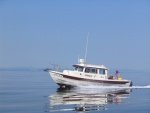Zuunami,
My experience, on Osprey, with the small screen and the scrolling ability has not been great. My homeport is a high commercial traffic area and things can get dicey quickly. The Garmin 9” screen, with the AIS overlay, makes identification and the decision process much easier. The images are clear, red in color (if active) and has a trackline, plus an alarm. Touch the screen, on the contact and you have the vessel’s name and other critical data, clearly in front of you.
Last week, while sailing my trimaran, I ran into a situation, that would make you a believer. I was sailing at about 13 kts, inbound, on the red side of the channel. I couldn’t go outside of the channel in that area, because of rocks. About 1/4 mile behind me was a tug, inbound, pushing barges. Ahead to starboard, was a Navy oiler, with two tugs, getting ready to get underway and both tugs were pushing the ship against the pier, creating a huge amount of turbulence. Then there was an outbound bulk cargo ship, forward, to port. Because of the wind shadow, from the ships, my speed dropped to 3 or 4 kts, then the turbulence of the prop wash from the tugs had an impact on my heading.
I needed to talk the the tug behind me, because my speed had temporarily dropped. If I had the AIS data in front of me, this would have been a lot smoother, because there were so many tugs near me and there was lots of activity on VHF channel 13.
I have a Garmin plotter on the trimaran and Friday, I ordered an AIS, which I received Sunday. I installed the AIS yesterday and will have a bit more help, next time that I am sailing.


